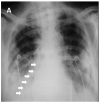Ultrasonographic Confirmation of Nasogastric Tube Placement in the COVID-19 Era
- PMID: 35330337
- PMCID: PMC8949067
- DOI: 10.3390/jpm12030337
Ultrasonographic Confirmation of Nasogastric Tube Placement in the COVID-19 Era
Abstract
Background: Nasogastric tube (NGT) placement is a daily routine in the Intensive Care Unit (ICU), and misplacement of the NGT can cause serious complications. In COVID-19 ARDS patients, proning has emerged the need for frequent NGT re-evaluations. The gold standard technique, chest X-ray, is not always feasible. In the present study we report our experience with the use of ultrasonographic confirmation of NGT position.
Methods: A prospective study in 276 COVID-19 ARDS patients admitted after intubation in the ICU. Ultrasonographic evaluation was performed using longitudinal or sagittal epigastric views. Examinations were performed during the initial NGT placement and every time the patients returned to the supine position after they had been proned or whenever critical care physicians or nurses considered that reconfirmation was necessary.
Results: Ultrasonographic confirmation of correct NGT placement was feasible in 246/276 (89.13%) patients upon ICU admission. In 189/246 (76.8%) the tube could be visualized in the stomach (two parallel lines), in 172/246 (69.9%) the ultrasonographic whoosh test ("flash" due to air instillation through the tube, seen with ultrasonography) was evident, while in 164/246 (66.7%) both tests confirmed correct NGT placement. During ICU stay 590 ultrasonographic NGT evaluations were performed, and in 462 (78.14%) cases correct NGT placement were confirmed. In 392 cases, a chest X-ray was also ordered. The sensitivity of ultrasonographic NGT confirmation in these cases was 98.9%, specificity 57.9%, PPV 96.2%, and NPV 3.8%. The time for the full evaluation was 3.8 ± 3.4 min.
Conclusion: Ultrasonographic confirmation of correct NGT placement is feasible in the initial placement, but also whenever needed thereafter, especially in the COVID-19 era, when changes in posture have become a daily practice in ARDS patients.
Keywords: POCUS; intensive care unit; nasogastric tube; ultrasonography.
Conflict of interest statement
The authors declare no conflict of interest.
Figures




References
-
- Itkin M., DeLegge M.H., Fang J.C., McClave S.A., Kundu S., d’Othee B.J., Martinez-Salazar G.M., Sacks D., Swan T.L., Towbin R.B., et al. Multidisciplinary practical guidelines for gastrointestinal access for enteral nutrition and decompression from the Society of Interventional Radiology and American Gastroenterological Association (AGA) Institute, with endorsement by Canadian Interventional Radiological Association (CIRA) and Cardiovascular and Interventional Radiological Society of Europe (CIRSE) Gastroenterology. 2011;141:742–765. - PubMed
-
- Boullata J.I., Carrera A.L., Harvey L., Escuro A.A., Hudson L., Mays A., McGinnis C., Wessel J.J., Bajpai S., Beebe M.L., et al. ASPEN Safe Practices for Enteral Nutrition Therapy Task Force, American Society for Parenteral and Enteral Nutrition. ASPEN Safe Practices for Enteral Nutrition Therapy. JPEN J. Parenter. Enter. Nutr. 2017;41:15–103. doi: 10.1177/0148607116673053. - DOI - PubMed
-
- Langer T., Brioni M., Guzzardella A., Carlesso E., Cabrini L., Castelli G., Dalla Corte F., De Robertis E., Favarato M., Forastieri A., et al. Prone position in intubated, mechanically ventilated patients with COVID-19: A multi-centric study of more than 1000 patients. Crit. Care. 2021;25:128. doi: 10.1186/s13054-021-03552-2. - DOI - PMC - PubMed
LinkOut - more resources
Full Text Sources

